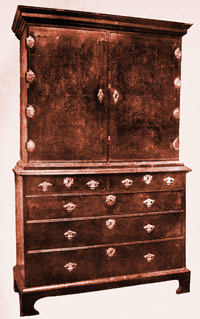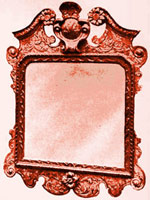Queen Anne Furniture Style
Queen Anne furniture style has its beginnings in the year 1689, a date prior to Anne succession, when the Prince of Orange became King of England. According to some authors, Queen Anne style is considered a part of the so-called Anglo-Dutch period, which includes the reigns of William and Mary (1689-1702), Queen Anne (1702-1714), and part of the reign of George I (1714-1727).
With the reign of William we see the Dutch furniture style coming into vogue, however it was heavily influenced by French art. In 1685, the Revocation of the Edict of Nantes caused many of the best French craftsmen to go into exile. Many took refuge in England, Germany, and the Low Countries, bringing with them their skills and the Louis XIV style.
One of the artists leaving France was Daniel Marot. He first went to Holland, where he was hired in the service of the future King of England. Once William became king, he appointed Marot as chief architect and master of works. As a result, Marot will exert the greatest influence in defining the Queen Anne style.

Queen Anne Cabinet
Marot’s designs were adopted both for the Queen Anne interior style and the furniture pieces, resulting in interesting models of chairs and bedsteads. The chairs usually had four turned legs with curved underbraces, upholstered seats, and solid backs. Their general character was still that of the Louis XIV style. The bedsteads were elaborate, with heavily draped canopies.
During the Queen Anne period, there were important changes in the interior decoration style. The main reason was the requirement of effectively displaying and preserving the porcelain pieces, the fireplaces being especially affected.
In cabinet-making, the reign of Queen Anne is associated with a style which bears the stamp of English individuality. Despite simplicity of form, neatness of workmanship lends a distinction which culminates into a refined beauty.
Marquetry cabinets were highly prized, and the craftsmen created beautiful specimens, including English marquetry on a walnut ground. The cabinets could have folding-doors beautifully inlaid with birds, insects and flowers in vases.
The most prized Queen Anne style cabinets are those decorated with marquetry in arabesque patterns, or with "cobweb " or "seaweed " panels. The cornice often contains a long, single drawer, and the inside of the doors is ornamented with marquetry panels.

Queen Anne Mirror Frame
Most of the Queen Anne furniture is veneered, cross-banded and inlaid, either on oak or pine. Both oak and pine were lacquered upon, and later in the century the less durable beech and sycamore were used. Lacquered panels were also imported and made up into the pieces of furniture. Overall, furniture was made of walnut, oak, beech, holly, birch, and yew, walnut holding the leading place.
During the reign of Queen Anne, carving was employed in simpler forms than during the Restoration period. It was cut on the surface, instead of forming the outlines. Common ornamental details included the shell, mascaron, cartouche, swags of flowers, acanthus leaves, and some classical designs.
The cabriole leg was used on chairs and tables, with the round, Dutch, or splay foot. Occasionally the cabriole had a shell ornament at the knee. This was not so common, because the walnut was not well suited to this type of carving, and usually it was undecorated. The chair was broad-seated, made usually of walnut, sometimes plain and sometimes decorated.
Generally, the front legs were cabriole, the back legs being simple curves or straight. Shell ornaments sometimes appeared on the knees, at the center of the front of the seat, and at the middle of the top of the back. The backs were high, curved to fit the back of the sitter, and the outline formed a continuous curve.
In the center of the back appeared a solid vase-shaped, fiddle-shaped, or lyre-shaped splat. The seats were broad, flat, and upholstered, and were usually shaped in curves both on front and sides, with rounded corners.
Some tables still retained the late Jacobean characteristics. However, the most common Queen Anne table style was the so-called "thousand-legged" table with round or square leaves and horse legs. The legs became slimmer and were still connected with the centre frame by stretchers close to the ground.
